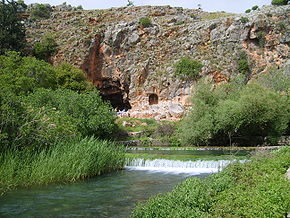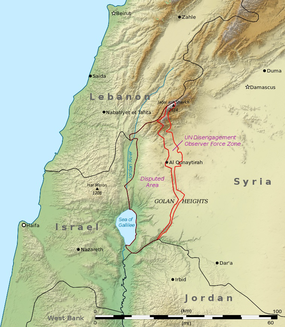Banias River
| بانياس الحولة בניאס |
|

The spring of Banias with the Cave of Pan in background
|
|
| Location | Mount Hermon north of the Golan Heights, controlled by Israel |
|---|---|
| Coordinates | 33°14′55″N 35°41′40″E / 33.24861°N 35.69444°ECoordinates: 33°14′55″N 35°41′40″E / 33.24861°N 35.69444°E |
| Type | the town of Caesarea Philippi with the sanctuary of Pan |
| History | |
| Cultures | Hellenistic, Roman, Byzantine, Early Islamic, Crusader |
| Site notes | |
| Archaeologists | Zvi Maoz (Area A, the temples area) and Vassilios Tzaferis (Area B, the central civic area) |
| Public access | yes (national park) |
Banias (Arabic: بانياس الحولة; Hebrew: בניאס) is the Arabic and modern Hebrew name of an ancient site that developed around a spring once associated with the Greek god Pan. It is located at the foot of Mount Hermon, north of the Golan Heights. The spring is the source of the Banias River, one of the main tributaries of the Jordan River. Archaeologists uncovered a shrine dedicated to Pan and related deities, and the remains of an ancient city founded sometime after the conquest by Alexander the Great and inhabited until 1967; the ancient city was mentioned in the Gospels of Matthew and Mark by the name of Caesarea Philippi.
The first mention of the ancient city during the Hellenistic period was in the context of the Battle of Panium, fought around 200-198 BCE, when the name of the place was given as Panion. Later the region was called Paneas (Greek: Πανειάς). Both names were derived from that of Pan, the god of the wild and companion of the nymphs.
The spring at Banias initially originated in a large cave carved out of a sheer cliff face which was gradually lined with a series of shrines. The temenos (sacred precinct) included in its final phase a temple placed at the mouth of the cave, courtyards for rituals, and niches for statues. It was constructed on an elevated, 80m long natural terrace along the cliff which towered over the north of the city. A four-line inscription at the base of one of the niches relates to Pan and Echo, the mountain nymph, and was dated to 87 BCE.
...
Wikipedia

